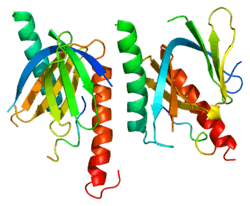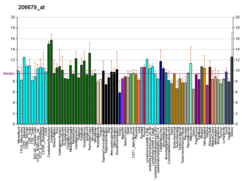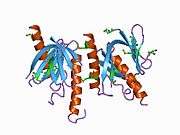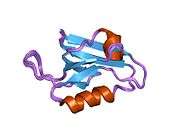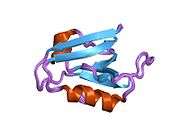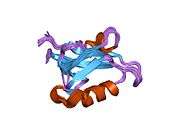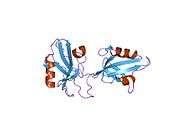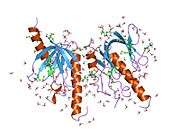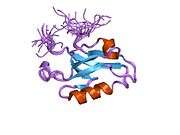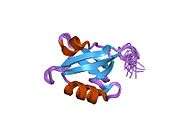APBA1
Amyloid beta A4 precursor protein-binding family A member 1 is a protein that in humans is encoded by the APBA1 gene.[5][6][7]
Function
The protein encoded by this gene is a member of the X11 protein family. It is a neuronal adaptor protein that interacts with the Alzheimer's disease amyloid precursor protein (APP). It stabilises APP and inhibits production of proteolytic APP fragments including the A beta peptide that is deposited in the brains of Alzheimer's disease patients. This gene product is believed to be involved in signal transduction processes. It is also regarded as a putative vesicular trafficking protein in the brain that can form a complex with the potential to couple synaptic vesicle exocytosis to neuronal cell adhesion.[7]
Interactions
APBA1 has been shown to interact with KCNJ12,[8][9] CCS,[10] CASK[11][12] and Amyloid precursor protein.[13][14]
References
- ENSG00000276497 GRCh38: Ensembl release 89: ENSG00000107282, ENSG00000276497 - Ensembl, May 2017
- GRCm38: Ensembl release 89: ENSMUSG00000024897 - Ensembl, May 2017
- "Human PubMed Reference:". National Center for Biotechnology Information, U.S. National Library of Medicine.
- "Mouse PubMed Reference:". National Center for Biotechnology Information, U.S. National Library of Medicine.
- Duclos F, Boschert U, Sirugo G, Mandel JL, Hen R, Koenig M (February 1993). "Gene in the region of the Friedreich ataxia locus encodes a putative transmembrane protein expressed in the nervous system". Proc Natl Acad Sci U S A. 90 (1): 109–13. doi:10.1073/pnas.90.1.109. PMC 45609. PMID 7678331.
- Duclos F, Koenig M (May 1995). "Comparison of primary structure of a neuron-specific protein, X11, between human and mouse". Mamm Genome. 6 (1): 57–8. doi:10.1007/BF00350899. PMID 7719031.
- "Entrez Gene: APBA1 amyloid beta (A4) precursor protein-binding, family A, member 1 (X11)".
- Leonoudakis D, Conti LR, Anderson S, Radeke CM, McGuire LM, Adams ME, Froehner SC, Yates JR, Vandenberg CA (May 2004). "Protein trafficking and anchoring complexes revealed by proteomic analysis of inward rectifier potassium channel (Kir2.x)-associated proteins". J. Biol. Chem. 279 (21): 22331–46. doi:10.1074/jbc.M400285200. PMID 15024025.
- Leonoudakis D, Conti LR, Radeke CM, McGuire LM, Vandenberg CA (April 2004). "A multiprotein trafficking complex composed of SAP97, CASK, Veli, and Mint1 is associated with inward rectifier Kir2 potassium channels". J. Biol. Chem. 279 (18): 19051–63. doi:10.1074/jbc.M400284200. PMID 14960569.
- McLoughlin DM, Standen CL, Lau KF, Ackerley S, Bartnikas TP, Gitlin JD, Miller CC (March 2001). "The neuronal adaptor protein X11alpha interacts with the copper chaperone for SOD1 and regulates SOD1 activity". J. Biol. Chem. 276 (12): 9303–7. doi:10.1074/jbc.M010023200. PMID 11115513.
- Borg JP, Straight SW, Kaech SM, de Taddéo-Borg M, Kroon DE, Karnak D, Turner RS, Kim SK, Margolis B (November 1998). "Identification of an evolutionarily conserved heterotrimeric protein complex involved in protein targeting". J. Biol. Chem. 273 (48): 31633–6. doi:10.1074/jbc.273.48.31633. PMID 9822620.
- Borg JP, Lõpez-Figueroa MO, de Taddèo-Borg M, Kroon DE, Turner RS, Watson SJ, Margolis B (February 1999). "Molecular analysis of the X11-mLin-2/CASK complex in brain". J. Neurosci. 19 (4): 1307–16. doi:10.1523/JNEUROSCI.19-04-01307.1999. PMC 6786035. PMID 9952408.
- Biederer T, Cao X, Südhof TC, Liu X (September 2002). "Regulation of APP-dependent transcription complexes by Mint/X11s: differential functions of Mint isoforms". J. Neurosci. 22 (17): 7340–51. doi:10.1523/JNEUROSCI.22-17-07340.2002. PMC 6757996. PMID 12196555.
- Borg JP, Ooi J, Levy E, Margolis B (November 1996). "The phosphotyrosine interaction domains of X11 and FE65 bind to distinct sites on the YENPTY motif of amyloid precursor protein". Mol. Cell. Biol. 16 (11): 6229–41. doi:10.1128/mcb.16.11.6229. PMC 231626. PMID 8887653.
Further reading
- van der Geer P, Pawson T (1995). "The PTB domain: a new protein module implicated in signal transduction". Trends Biochem. Sci. 20 (7): 277–80. doi:10.1016/S0968-0004(00)89043-X. PMID 7545337.
- Chen WJ, Goldstein JL, Brown MS (1990). "NPXY, a sequence often found in cytoplasmic tails, is required for coated pit-mediated internalization of the low density lipoprotein receptor". J. Biol. Chem. 265 (6): 3116–23. PMID 1968060.
- Borg JP, Ooi J, Levy E, Margolis B (1996). "The phosphotyrosine interaction domains of X11 and FE65 bind to distinct sites on the YENPTY motif of amyloid precursor protein". Mol. Cell. Biol. 16 (11): 6229–41. doi:10.1128/mcb.16.11.6229. PMC 231626. PMID 8887653.
- Zhang Z, Lee CH, Mandiyan V, Borg JP, Margolis B, Schlessinger J, Kuriyan J (1997). "Sequence-specific recognition of the internalization motif of the Alzheimer's amyloid precursor protein by the X11 PTB domain". EMBO J. 16 (20): 6141–50. doi:10.1093/emboj/16.20.6141. PMC 1326298. PMID 9321393.
- Okamoto M, Südhof TC (1998). "Mints, Munc18-interacting proteins in synaptic vesicle exocytosis". J. Biol. Chem. 272 (50): 31459–64. doi:10.1074/jbc.272.50.31459. PMID 9395480.
- Blanco G, Irving NG, Brown SD, Miller CC, McLoughlin DM (1998). "Mapping of the human and murine X11-like genes (APBA2 and apba2), the murine Fe65 gene (Apbb1), and the human Fe65-like gene (APBB2): genes encoding phosphotyrosine-binding domain proteins that interact with the Alzheimer's disease amyloid precursor protein". Mamm. Genome. 9 (6): 473–5. doi:10.1007/s003359900800. PMID 9585438.
- Borg JP, Yang Y, De Taddéo-Borg M, Margolis B, Turner RS (1998). "The X11alpha protein slows cellular amyloid precursor protein processing and reduces Abeta40 and Abeta42 secretion". J. Biol. Chem. 273 (24): 14761–6. doi:10.1074/jbc.273.24.14761. PMID 9614075.
- Butz S, Okamoto M, Südhof TC (1998). "A tripartite protein complex with the potential to couple synaptic vesicle exocytosis to cell adhesion in brain". Cell. 94 (6): 773–82. doi:10.1016/S0092-8674(00)81736-5. PMID 9753324.
- Borg JP, Straight SW, Kaech SM, de Taddéo-Borg M, Kroon DE, Karnak D, Turner RS, Kim SK, Margolis B (1998). "Identification of an evolutionarily conserved heterotrimeric protein complex involved in protein targeting". J. Biol. Chem. 273 (48): 31633–6. doi:10.1074/jbc.273.48.31633. PMID 9822620.
- Borg JP, Lõpez-Figueroa MO, de Taddèo-Borg M, Kroon DE, Turner RS, Watson SJ, Margolis B (1999). "Molecular analysis of the X11-mLin-2/CASK complex in brain". J. Neurosci. 19 (4): 1307–16. doi:10.1523/JNEUROSCI.19-04-01307.1999. PMID 9952408.
- Maximov A, Südhof TC, Bezprozvanny I (1999). "Association of neuronal calcium channels with modular adaptor proteins". J. Biol. Chem. 274 (35): 24453–6. doi:10.1074/jbc.274.35.24453. PMID 10455105.
- Mueller HT, Borg JP, Margolis B, Turner RS (2001). "Modulation of amyloid precursor protein metabolism by X11alpha /Mint-1. A deletion analysis of protein-protein interaction domains". J. Biol. Chem. 275 (50): 39302–6. doi:10.1074/jbc.M008453200. PMID 11010978.
- Biederer T, Südhof TC (2001). "Mints as adaptors. Direct binding to neurexins and recruitment of munc18". J. Biol. Chem. 275 (51): 39803–6. doi:10.1074/jbc.C000656200. PMID 11036064.
- Lau KF, McLoughlin DM, Standen C, Miller CC (2001). "X11 alpha and x11 beta interact with presenilin-1 via their PDZ domains". Mol. Cell. Neurosci. 16 (5): 557–65. doi:10.1006/mcne.2000.0898. PMID 11083918.
- McLoughlin DM, Standen CL, Lau KF, Ackerley S, Bartnikas TP, Gitlin JD, Miller CC (2001). "The neuronal adaptor protein X11alpha interacts with the copper chaperone for SOD1 and regulates SOD1 activity". J. Biol. Chem. 276 (12): 9303–7. doi:10.1074/jbc.M010023200. PMID 11115513.
- Bécamel C, Alonso G, Galéotti N, Demey E, Jouin P, Ullmer C, Dumuis A, Bockaert J, Marin P (2002). "Synaptic multiprotein complexes associated with 5-HT(2C) receptors: a proteomic approach". EMBO J. 21 (10): 2332–42. doi:10.1093/emboj/21.10.2332. PMC 126011. PMID 12006486.
- Ho CS, Marinescu V, Steinhilb ML, Gaut JR, Turner RS, Stuenkel EL (2002). "Synergistic effects of Munc18a and X11 proteins on amyloid precursor protein metabolism". J. Biol. Chem. 277 (30): 27021–8. doi:10.1074/jbc.M201823200. PMID 12016213.
External links
- Human APBA1 genome location and APBA1 gene details page in the UCSC Genome Browser.
- Overview of all the structural information available in the PDB for UniProt: Q02410 (Amyloid-beta A4 precursor protein-binding family A member 1) at the PDBe-KB.
